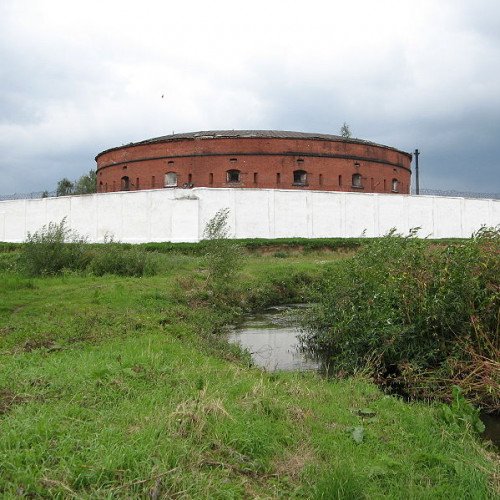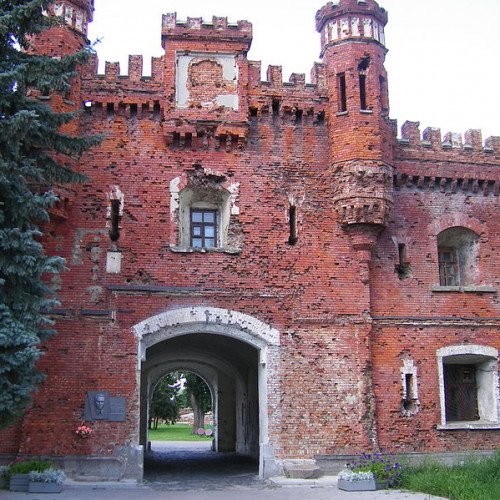Castles of "Belarus" BABRUYSK FORTRESS vs BREST FORTRESS

BABRUYSK FORTRESS
The Babruysk Fortress (Belarusian: Бабруйская крэпасць, Russian: Бобруйская крепость) is a historic fortress in the city of Babruysk, Belarus that was built between 1810 and 1836. It is one of the best surviving examples of fortification architecture and design in the first half of the 19th century. The fortress was constructed in the historic center of the city, at the confluence of the Babruyka and Berezina rivers. It was one of the western Russian fortresses. In 1810, Tsar Alexander I sent out his military engineer Teodor Narbutt to find a site suitable for building a fortress somewhere on the Dnieper, between Mogilev and Rogachev in order to prepare for the looming threat in Western Europe. However, after his investigation, Narbut advised his superiors that a more strategic position would be on the shore of the Berezina river near Babruysk. This decision was approved by the Chief of Military Engineers, Count Carl Operman, who at the time had authority over all of Russian forts. On June 4, 1810, the Tsar issued an order for the Babruysk fortress to be constructed. Narbut had to resign for health reasons and was replaced by General Major Gabriel Ignatiev. The early fortress comprised five bastions, multiple soil ridges, and water channels. The basis for the Babruysk fortress was the Babruysk Jesuit house and a smaller Polish fortress, which were built earlier. Only partially completed, the fortress had to face Napoleon's invading army in the summer of 1812. After the French army captured Minsk, General Ignatiev took command of the fort and the city of Babruysk, which served as a holdout for the retreating Russian forces. Soldiers from The Second Russian Army were provided with food and the wounded received medical treatment. After that they were ferried by the Berezina and Dniper to Smolensk, where the main Russian army was stationed. General Ignatiev remained in the fortress and oversaw its defence. The city faced an attack by the forces of General Dombrawski, the Polish Corps Commander of Napoleon's Army. The siege lasted for four months, however the fortress held until the French forces began their retreat. Throughout this time Ignatiev was instrumental in collecting intelligence and forwarding it to the high command of the Russian army. Following the Napoleonic wars, in 1820, the fortress was further rapidly expanded by the addition of 18 more bastions and towers. The fort Freidrich Wilhelm was designed according to the plans of the architect A. Staubert in 1822. Tsar Alexander I himself and his brother arrived in Babruysk on September 24, 1825, at the completion of this building phase.
Statistics for this Xoptio

BREST FORTRESS
Brest Fortress (Belarusian: Брэсцкая крэпасць, Bresckaja krepasć; Polish: Twierdza brzeska), formerly known as Brest-Litoŭsk Fortress, is a 19th-century fortress in Brest, Belarus. In 1965, the title "Hero Fortress" was given to the fortress to commemorate the defence of the frontier stronghold during the first week of the Operation Barbarossa when Axis forces invaded the Soviet Union on June 22, 1941. The title "Hero Fortress" corresponds to the title "Hero City" that the Presidium of the Supreme Soviet of the Soviet Union awarded to twelve Soviet cities. The Brest fortress has sustained its original outline of a star shaped fortification since its construction in the early 19th century. The Citadel, the core of the fortress, was on the central island formed by the Bug River and the two branches of the Mukhavets River. The island was skirted by a ring of a two-storied barrack with 4 semi-towers. The 1.8 km long barrack comprised 500 rooms to accommodate 12,000 soldiers within thick walls built from super strong red bricks. Originally there were 4 gates to enter the Citadel. Today only Kholm Gate and Terespol Gate can be seen, most part of the barrack lies in ruins. The Citadel was surrounded by 3 fortifications as bridgeheads, that were made up by branches of the Mukhavets River and moats (ditches), fortified by earthworks 10 m high with redbrick casemates inside. The 3 fortifications were named after two towns: Russian name for the city of Kobryn in Belarus, Terespol in Poland and Volyn, a historic region of Volhynia majorly located in Ukraine. The Kobrin Fortification was the biggest in the fortress, located in the northeastern part, shaped like a horseshoe, featured 4 fortification curtains, 3 detached ravelins and a lunette in the western part, East Fort and West Fort. The Terespol Fortification was the western bridgehead, featuring 4 detached lunettes. The Volyn Fortification was the southeastern bridgehead, featuring 2 fortification curtains with 2 detached ravelins.